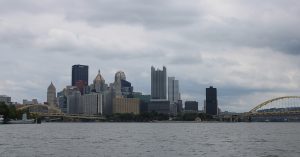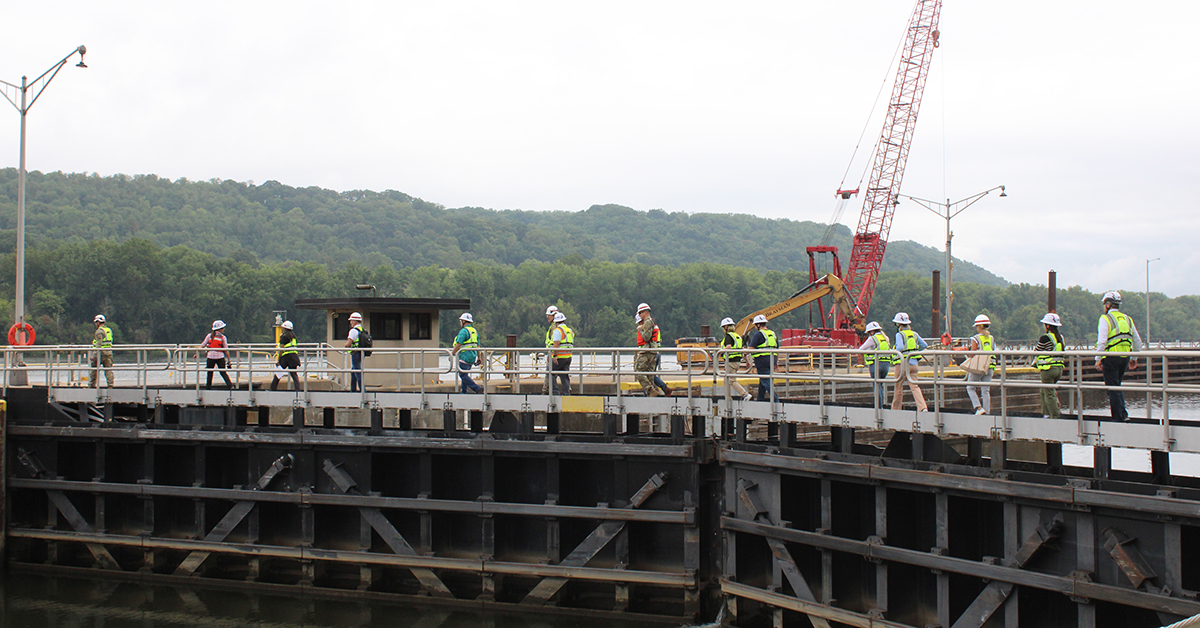Representatives from Waterways Council Inc. (WCI), an advocacy organization for the inland waterways and ports, are used to talking about why locks and dams need full and efficient funding. On a media tour August 19–21, however, they also showed visiting reporters and industry leaders exactly why.
As part of an annual media tour, WCI brought reporters from New York, Chicago, New Orleans, Pittsburgh and Paducah, Ky., together to see construction taking place to build a new, larger lock chamber at Montgomery Locks and Dam on the upper Ohio River in Monaca, Pa. The new chamber, which will measure 600 feet long by 110 feet wide, is being built over the footprint of the auxiliary lock, which is 360 feet long and 56 feet wide. The construction is taking place while the Pittsburgh Engineer District and the contractor, a joint venture by Trumbull Construction Corporation and Brayman Construction Corporation, keep the current main chamber open to ensure continued navigability on the river. (See more about this project in the September 1 issue of The Waterways Journal.)
The group had the opportunity to cross the lock gates and climb high onto the dam, watching as specialized equipment worked to demolish an approach guidewall. On the other end of the project site, construction workers were hard at work completing the final details of a batch concrete plant that will pour the concrete monoliths needed for the new chamber.
Media members then took a ride on one of Pittsburgh’s Gateway Clipper Fleet’s boats down the Monongahela River, past the point where it converges with the Allegheny to form the upper Ohio at Pittsburgh’s Point State Park, turning around within sight of the also aging and antiquated Emsworth Locks and Dam.
Montgomery, Dashields and Emsworth locks and dams together make up the Upper Ohio Navigation Project, a multi-billion-dollar construction project that will transform the three oldest and smallest locks on the Ohio River. Congress authorized the project in 2016. Construction on Montgomery Locks and Dam was the first to break ground, with the new lock construction contract awarded last September.
The media tour was also an opportunity to show off Pittsburgh, its waterways and even its sports. The group took in a Pittsburgh Pirates baseball game and had a dinner meeting with regional industry stakeholders.
WCI Senior Vice President Deb Calhoun said the media tours have been taking place for about a decade and are important to getting WCI’s message out.
“WCI annually hosts its media tour for reporters to see, up close, what it is Waterways Council advocates work for every day: modern, efficient, reliable lock and dam infrastructure and channel maintenance,” she said. “These tours, held at different active lock construction project sites around the country, offer that opportunity. Seeing Montgomery Lock this year and hearing from the Corps of Engineers will, I think, give reporters a better understanding of what it takes to build a megaproject on the inland waterways system, why it is so important to the nation to recapitalize lock structures that were built in the 1920s and 1930s, how much economic benefits and how many jobs are produced and connected to these projects, and the critical way the rivers facilitate competition in the world market for America.”
Calhoun said it was gratifying to be able to get reporters to leave their offices and travel to different parts of the country to see these lock projects and to spend time with the Corps and WCI staff.

“The inland waterways system can be out of sight, out of mind, but we are trying to highlight the multitude of benefits and to elevate the importance of this critical system,” she said.
At a dinner with stakeholders, industry leaders who compete against each other for some of the same market share came together to express a common interest in maintaining the waterways for all.
Peter Stephaich, executive chairman of Campbell Transportation Company, a Pittsburgh-based inland marine transportation and services company, was among those who welcomed the group and stressed how Pittsburgh’s waterways link with those around the country as one interconnected system that moves freight efficiently and economically.
“We all appreciate the media taking an interest in this because we’re kind of quiet,” he said. “We’re out of mind. Most people don’t understand what we do as businesses, the amount of tons we move and how we move them, safely, quietly and efficiently, from an environmental and fuel efficiency point of view.”
Altogether, the nation’s river system moves some 500 million tons of cargo annually, Stephaich said, noting that if they had to be rerouted via another mode of transportation that it would have “a tremendous impact” not just on road congestion but on pollution and safety.
“We really appreciate whatever you guys can do to get the word out,” Stephaich said. “We’re not looking to spin this or come up with inflated numbers. The numbers are the numbers, and it’s a very real story.”
He added that it was a constant battle to educate people about the industry, its needs and its value to the nation.
Scott Turer, chief financial officer for Three Rivers Marine and Rail Terminals in Charleroi, Pa., praised WCI and the Port of Pittsburgh, which helped to sponsor the tour.
“It’s really important to America to keep the waterways in top condition,” he said. “Our inland river system here is the envy of other nations, and it’s such a great asset that we have, and it supports millions of jobs and millions of industries.”
Angela Grett, vice president of corporate affairs for Ingram Marine Group, has attended multiple media tours and said she thought it was helpful that those attending got to see the progress made on the Montgomery project since media members visited three years ago on the WCI tour.
Grett said she came away very optimistic and excited, especially seeing new techniques such as 3D modeling that are being used and that she thinks will make a difference in delivering these types of projects faster.
“Making our system more efficient is going to be huge for us,” she said, adding that avoiding unplanned maintenance and lock closures is key.
“We feel that as an industry, not just one company,” Grett said. “Anything that we can do to deliver and finalize these projects is a very good thing.”
————
Featured photo caption: Participants in Waterways Council Inc.’s annual media tour, wearing hard hats, safety glasses and reflective vests, cross a walkway atop of a lock gate at Montgomery Locks and Dam. (Photo by Shelley Byrne)




